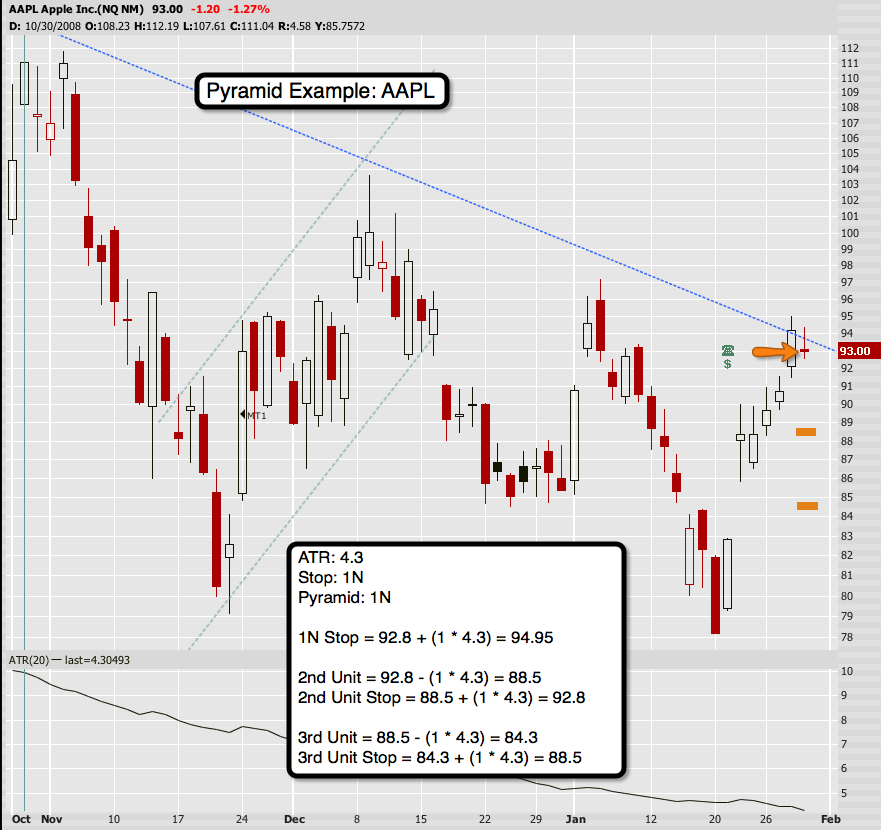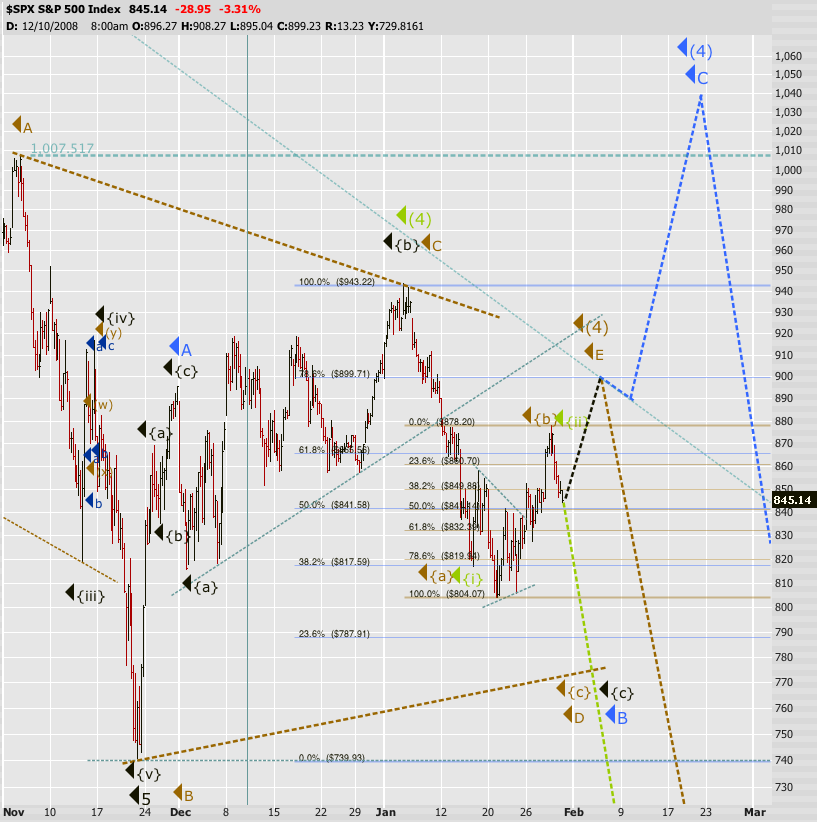Calculitious!
Calculitious!
You guys held up well without me today and I think it’s time for a little reward. I already mentioned that I was doing a lot of trend trading before this market turned so volatile. FYI – as you might imagine trend trading becomes a lot more difficult when implied volatility is on the rise:
But when I was still chasing long term discretionary trend trades I also became a big fan of pyramiding. No – we’re not talking about a pyramid (ponzi) scheme a la Madoff – I’ll teach you that one later 🙂
What I’m talking about is a popular technique of stacking additional units (i.e. positions) on top of your first one as the trade goes in your favor, therefore confirming the trend. The way to do that is to decide on some kind of price interval at which you add to your additional ‘units’. The turtles used a 10-day ATR (average true range), which is an expression of how much a stock moves on average within a 10 day range. That number becomes ‘N’ – the number you multiply by whatever risk ratio you prefer. Pick something else if you like but ATR has treated me very well in the past.
Depending who you asked the turtles used either 1N or 2N as their stop – there’s also talk that they used 1/2N on the first day and then bumped it up to 1N or 2N but I tried that and it got me kicked out of trades very quickly.
The best way to explain this and really understand it is to look at an example. For instance, I grabbed AAPL before the close at a spot which I think might lead to some downside – tomorrow’s tape will show me whether or not I should have my head examined.
The first thing I look at is the 10-day ATR, which in this case is 3.7. However, I screwed up here and actually picked the 20-day ATR, which is 4.3 – so sue me! Now what I have to decide on are my stop and the pyramid interval. Usually I use a 2N stop but since there is a resistance line I decided to use a 1N stop. My plan is to add 2 additional units at a 1N interval if the trade goes my way.
The calculation for all this is on the chart – I set an alert (i.e. mental stop) in TOS at 94.95, which is 4.3 points away from my entry (1N). If that gets hit I will cut my position. I also set an alert at 88.5, which is where I would add my 2nd unit – probably the same strike, as I want the first one to pay for the second one. Ahaaaa – I think some of you just had an epiphany! 😉 Finally, the new unit also needs a (mental) stop, and based on your trading system you either set the stop for all your units to the next stop point at 92.8, or you leave your original stop for the first unit in place and also set one for your 2nd unit. The impact of that is a different discussion and I don’t want to confuse you today. Same game for the third one – if 84.3 gets hit we add one more unit and also set one more stop at 88.5
Now, the idea here obviously is to ride a trend as it unfolds – the further it goes your way the more you add and if you are lucky you sit on three or four units as the underlying stock keeps moving your way. The maximum for me has been 5 units and only when the trend was unidirectional, fast, and clear. The result – less initial risk and compounding profits!
The problem here of course is that all this math makes your head spin and it’s almost impossible to do this while you’re trading. And even if you do it for the first unit you probably forgot your settings once the next unit comes knocking at your door. Heck, even writing this little intro was a piece of work!
But have no fear – evil Mole to rescue! Sometime last year I got sick of doing this by hand over and over again – although I’m actually pretty good in math – but I’m also equally lazy. So, I sat down and wrote a simple browser based JavaScript utility that does it all for me in an instant:
All you do is to first select your stop and pyramid setting in the drop downs. Then you type in a symbol – it won’t go online and get the data – LOL – not that sophisticated. It’s so you know what the numbers belong to. then you select whether it’s a short or long trade – that’s important as it reverses the direction. Finally you type in the current ask price and the ATR. The rest is all done for you and all that’s left is to set your alerts (or stop orders if you like) in your trading platform. I usually only set one unit alert and the stop at first – after all you don’t know if the trade will go your way. Then you set the next alert when another unit is due.
The final task is to use jing or your favorite screen grabber to take an image of your trade setup and store it somewhere. I actually post it on a private blobspot site, which is password protected. So, when my alert hits I add my unit, then look up AAPL in my blog and set the next unit plus the stop alert based on the image. You ‘could’ recalculate it of course but that’s too much work and you never get the perfect entry anyway.
So, where can you find this coveted NCalc utility for which many traders would give their firstborn just to bask in its glory? Well, right here:
https://evilspeculator.com/ncalc/
That’s it – it’s free to use for all you leeches – so you might want to bookmark that sucker. Remember that you don’t have to be a trend trader to leverage this tool. Just calculating your stop usually is enough of a pain, so this will do it for you. But it’s also a good tool for your own trading blog as you basically ‘commit’ to your trade when you place it. From then on it’s all in black & white and there’s no changing plans afterward.
One more tip – make sure you reload the page once a day as the date does not change automatically. The time however changes, so not only do you have a track record of your trade, you also know what date and time you placed it. Perfect for your trading journal/blog.
Before I let you go, let’s do a quick review of today’s tape: The chart is a bit messy but don’t let that intimidate you – I’ll explain.
- The green line can now apply to the green or orange scenario – meaning either today’s highs (which I missed out on – grrrrr) were the top of minor 2 of intermediate (5) or it was the top of minor wave E of intermediate wave (4). If it was the former then we should keep dropping here and that pronto as we should now be in wave 3 of (5) – no more of frustrating whipsaw action. Gaps should only happen towards the downside, not the upside. So, we’ll probably know fairly soon if this one is playing out.
- The orange line scenario would have us rally to the upside fairly soon, I think 840 is what I would be looking at, bringing us to our 900 zone which we have been coveting. This would also give us relative equality with the first a wave up and thus produce a nice a/b/c. Tomorrow or Monday is when it needs to happen, so this scenario is also due to finally resolve or walk into the sunset.
- The blue scenario shares its path with the orange one until the separation point around 900. If we keep pushing past 920 it would be strike 1 for blue, and if we push past the prior 944 top then that would be strike 2. To continue our baseball analogies – home base would be at around 1020 – 1040. We would probably not get there in a straight line, so if this scenario unfolds expect more of this torturous tape we had to condone during the past week or so.
Also note how nicely the two Fibonacci scales fit into each other – the 50% lines are overlapping and the 100% and 0% lines fit right inside centers of the large ones. I’m not sure what this means, but it’s worth mentioning as it is a tribute to how omnipresent and magnificent the ‘golden spiral’ really is. Sometimes you see something that has meaning – you know it instantly – you don’t know what exactly its meaning is, and sometimes it takes you a long time figure out. But when we see truth or something truly beautiful we recognize it instantly.
In that spirit I am dedicating tonight’s post to Leonardo Fibonacci. We all greatly benefit from his work on a daily basis, but rarely do I see a tribute to his work and his genius.
‘A. Leonardo Fibonacci, Insigne Matematico Piisano del Secolo XII.’


















